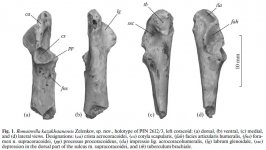Fred Ruhe
Well-known member

Nikita V. Zelenkov, 2018
The Earliest Asian Duck (Anseriformes: Romainvilla) and the Origin of Anatidae
Doklady Biological Sciences, 2018, Vol. 483, pp. 225–227.
Abstract:
A new species of the extinct duck Romainvilla from the Upper Eocene of Kazakhstan is described. This is the earliest duck from Asia, the first record of Romainvilla beyond France and the first reliable evidence of the presence of Romainvillinae (regarded here as family) in Asia. This occurrence shows a wide range of Romainvilla and suggests a greater similarity of Late Eocene faunas of Western Europe and Asia than it was previously thought. The origin of Romainvillidae and their presumable descendants Anatidae may be connected with adaptation to a new biotope, the shallowing Late Eocene epicontinental Asian basins (due to a global decrease in sea level).
Free pdf: https://www.researchgate.net/public...formes_Romainvilla_and_the_Origin_of_Anatidae
Enjoy,
Fred
The Earliest Asian Duck (Anseriformes: Romainvilla) and the Origin of Anatidae
Doklady Biological Sciences, 2018, Vol. 483, pp. 225–227.
Abstract:
A new species of the extinct duck Romainvilla from the Upper Eocene of Kazakhstan is described. This is the earliest duck from Asia, the first record of Romainvilla beyond France and the first reliable evidence of the presence of Romainvillinae (regarded here as family) in Asia. This occurrence shows a wide range of Romainvilla and suggests a greater similarity of Late Eocene faunas of Western Europe and Asia than it was previously thought. The origin of Romainvillidae and their presumable descendants Anatidae may be connected with adaptation to a new biotope, the shallowing Late Eocene epicontinental Asian basins (due to a global decrease in sea level).
Free pdf: https://www.researchgate.net/public...formes_Romainvilla_and_the_Origin_of_Anatidae
Enjoy,
Fred




